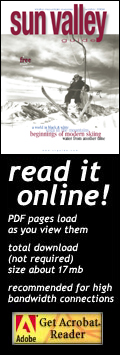| click here for the |
| front page |
| features |
| proctor,ruud+dollar |
| beyond boarding |
| bell,odmark+puchner |
| trinity springs water |
| arts |
| black+white photos |
| jack burgess |
| r.l. rowsey |
| living |
| yoga |
| decorative concrete |
| recreation |
| vO2 workouts |
| snowshoeing |
| dining |
| scotch |
| stews |
| calendar |
| winter 2003-2004 |
| to-do |
| sun valley essentials |
| listings |
| galleries |
| dining |
| fitness |
| equipment rentals |
| outfitters + guides |
| lodging |
| maps |
| ketchum + sun valley |
| local art galleries |
| the guide |
| last summer |
| advertising |
| about us |
| copyright |
|
Copyright
© 2003 Express Publishing Inc. All Rights reserved. Reproduction in whole or in part in any form or medium without express written permission of Express Publishing Inc. is strictly prohibited. |
|
Produced
& Maintained by Express Publishing, Box 1013, Ketchum, ID 83340-1013 208.726.0719 Voice 208.726.2329 Fax info@svguide.com |
|
The
Sun Valley Guide is distributed free twice yearly to
residents and guests throughout the Sun Valley, Idaho resort area
communities.
Subscribers to the Idaho Mountain Express will receive the Sun Valley Guide inserted into the paid edition of the newspaper. |

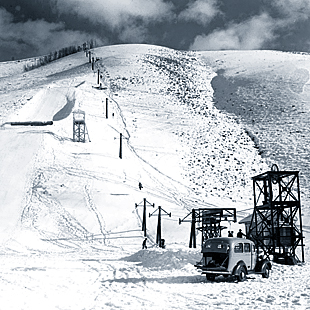
photo courtesy The Community Library, Regional History
Dept
Proctor, Ruud & Dollar Mountains
the beginnings of modern alpine skiing
by Dick Dorworth
(The chairlift on Ruud Mountain, above, built in 1938, still stands today toward the end of Fairway Road in Sun Valley.)
It is indisputable that without ski lifts and the alpine skiing they allowed, the past and present of the entire Sun Valley area would be very different than they are. What is even less appreciated is that without Sun Valley and its contribution to the development of ski lifts, the history of skiing throughout the world would be very different.
A bit of reflection on the progression of chairlift development in Sun Valley, the nation’s first destination ski resort, makes this clear and can be experienced by snowshoeing, ski touring or hiking to these sites.
The first chairlifts in the world were invented and built in Sun Valley by Union Pacific Railroad in 1936 at founder Averell Harriman’s instigation. One of Union Pacific’s engineers, Jim Curran, was charged with the job of creating a new and easy way to haul skiers uphill.
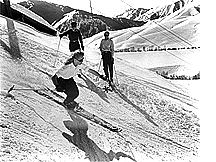 Skier
Bobbie Bennett descends Ruud Mountain. photo courtesy The
Community Library, Regional History Dept
Skier
Bobbie Bennett descends Ruud Mountain. photo courtesy The
Community Library, Regional History Dept
Curran had already developed a cable system in Ecuador for loading bananas onto freighters for the United Fruit Company, which was famous for using U.S. government and military influence to economically colonize and export fruit from Central America and parts of South America. He immediately understood that, from an engineering-transportation perspective, people and bananas were not that different. Two hundred pounds of human flesh and ski gear could be moved about as easily as a similar weight of inert fruit, and Curran designed the first chairlifts for skiers based on what worked for bananas in Ecuador.
The first two of those lifts were installed on Dollar and Proctor mountains in 1936, the third two years later on Ruud Mountain. Of those original lifts, the only one still standing is on Ruud Mountain, named after the famous Norwegian ski jumpers, Sigmund and Birger Ruud. The Proctor Mountain lift is no longer there, though in the summer decaying remnants of the lift poles and cable can be found in places disintegrating back into the earth. Dollar Mountain is still operating, but the original lifts have been replaced several times in the last 67 years.
From the base of Ruud Mountain, looking up the lift line, one can still see the outline of Sun Valley’s original ski jump just to the left of the lift. The first operating chairlift in the world was on Proctor Mountain, beginning in a canyon just north of Ruud and ending on the ridge directly above the top of the Ruud Mountain lift. Proctor lift and Dollar lift, a short distance away, were built the same summer. Proctor was finished first, thus garnering the first place title.
Although Ruud Mountain and Proctor Mountain are part of the same geologic formation, Ruud Mountain lift was added in the summer of 1938 because the northern exposure of the Proctor lift proved “too cold” for Sun Valley’s first, fair weather skiers.
Winter or summer, one can see the old Ruud Mountain lift up close simply by driving to the northeast end of Fairway Road in Sun Valley. This is one point to begin exploring one of several routes through Sun Valley ski history, though the same terrain can be reached with better parking from Trail Creek and Corral Creek off the Trail Creek Road. Both Ruud and Proctor mountains are popular ski touring destinations.
Proctor Mountain was named for Charlie Proctor, a Nordic competitor in the 1928 Olympics for the United States. He helped Harriman get the Sun Valley resort going, and was a significant figure in the early years of American skiing including helping develop Yosemite’s Badger Pass Ski Area. Proctor’s daughter, Peggy Dean, grandson, Ryan Dean, and great-grandson, Shaw Proctor Dean, still live in the Wood River Valley.
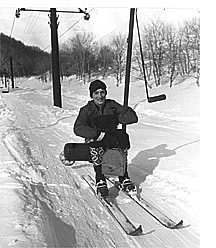 Mr.
A. R. Phipps, catches a ride up Proctor Mountain.
photo courtesy The Community Library, Regional History Dept
Mr.
A. R. Phipps, catches a ride up Proctor Mountain.
photo courtesy The Community Library, Regional History Dept
Proctor Mountain is where it all started, American lift-serviced alpine skiing that has grown since 1936 into a huge industry and way of life that has been a direct or indirect influence on the lives of everybody reading this and many others as well. For the devout, historically minded skier, Proctor is a shrine, among the holy of holies, a place steeped in the past of Sun Valley, the larger world of skiing and a certain kind of lifestyle familiar to those living in the Wood River Valley.
While Ruud Mountain was still used into the early 1960s for at least ski races and the occasional ski jumping competition, Proctor Mountain’s lift hasn’t operated since 1950. In that year, the chilly mountain access was opened solely for Sun Valley employees.
Having a mountain just for employees was in line with Sun Valley’s practice of having a watering hole only for employees. This was the Holiday Hut behind the Challenger Inn (now known as the Sun Valley Inn). The Quonset hut in which it operated is still standing and used by Sun Valley Company, current owner of the resort.
Dick Moulton, a member of the Sun Valley Ski Patrol in the late 1940s and early 1950s, remembers a day on Proctor Mountain with the legendary American ski racer and daredevil Dick Buek:
“We had several members of the 1952 Men’s Olympic Team on the patrol, including Dick Buek. Dick was a great guy and became famous for his daring deeds. Union Pacific used to furnish ski passes to their employees and one year they decided to keep Proctor Mountain open just for the use of the employees. That was a good deal as Proctor was a good ski mountain with a lot of varied terrain and good snow. One day Buek and I had the Ski Patrol duty on Proctor Mountain. It was our usual practice when we closed the mountain in late afternoon to wait until all the other skiers had made it to the bottom and then we would ski non-stop to the bottom. On this particular day, Buek told me that he had found a ‘great’ run that we should ski when we closed the mountain. After all the skiers had left the top, we skied across to the base of a cliff. We took our skis off and kicked steps up as far as we could and then put our skis back on. Buek took off first in a low crouch and was soon out of sight. I then took off. For the first part of the schuss it was very fast on frozen snow (it was spring time) and then as I approached the bottom I hit very soft snow all at once and that is all she wrote! I took one of the worst spills ever. I was very lucky I didn’t break anything. This was one of the hazards of skiing with Dick Buek.”
If one looks carefully on the north side of the mountain, the lift line to the top of Proctor Mountain can still be discerned. At the top was the site of the Proctor Mountain Cabin (also known as the Hot Potato Hut). It was the 1930s equivalent of today’s Lookout Restaurant or Seattle Ridge Lodge on Bald Mountain. After Proctor Mountain was no longer open for skiing, the hut was moved to Sun Valley and became part of the Sun Valley Gun Club.
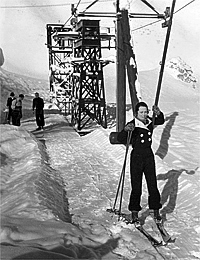
A skier loads on the Proctor chairlift circa 1936. The chairlift was built on technology used in Ecuador for loading bananas on freighters.photo courtesy The Community Library, Regional History Dept
Florian Haemmerle worked sometimes as a cook in the Hot Potato Hut. Haemmerle, a Bavarian, was the director of the Sun Valley Backcountry Ski School, the first of its kind in America. Hans Hauser, an Austrian, directed the alpine ski school and most of the members of that ski school were Austrian.
As everyone familiar with world history of that time appreciates, in the late 1930s there was an abundance of ill will between Austria and Germany and, because of it, Haemmerle could not be on the alpine ski school. Still, he was a fine man, popular and an excellent skier. Harriman did not want to lose him, so he helped Haemmerle develop and direct the backcountry ski school. (Eventually Haemmerle and Hauser became roommates and friends, as the artificial barriers of nationalism gave way before the organic connections of common interests, good fellowship and basic humanity.)
Then as now, far more
people are interested in getting 10 mechanical rides to the top of the
mountain to enjoy 10 ski runs down than there are those who want to
climb to the top of the mountain once a day and have one run down.
Still, backcountry ski mountaineering has a significant following, and
in the Sun Valley area the pioneers were Haemmerle and his group of
guides and their clients who explored the Pioneer Mountains, the Boulder
Mountains, the Smoky Mountains and even north into the Sawtooth
Mountains before World War II. Then as now, the best of them honed their
skiing skills by riding the lifts and getting in more turns, more
downhill mileage, more of the thrills of skiing with less of the labor.
In the first days of Sun Valley, the hub of both alpine and backcountry skiing was Proctor, Ruud and Dollar mountains, and the history of skiing throughout the world was changed by the technology, the events and the people connected with those few hills in central Idaho. When Bald Mountain opened near Ketchum in December of 1939, it expanded the possibilities of Sun Valley skiing and added to the history of world skiing, but the genesis was on the other side of the Wood River Valley.
One of the few known photos of Austrian Count Felix Schaffgotsch actually skiing was taken on Proctor Mountain. Schaffgotsch was the man Harriman commissioned to find the right location in Western America for a world-class ski resort.
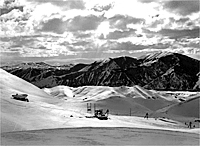 The
north slope of Proctor Mountain was the site of one of the world’s first
three chairlifts. photo
courtesy The Community Library, Regional History Dept
The
north slope of Proctor Mountain was the site of one of the world’s first
three chairlifts. photo
courtesy The Community Library, Regional History Dept
Schaffgotsch discovered Ketchum-Sun Valley and the rest, truly, is history. Schaffgotsch, who was variously described as a not very good skier, intelligent, graceful, charming and a bit arrogant, later died on the Russian front fighting in WWII for the Third Reich. He should have stayed in Sun Valley.
An easy day of snowshoeing or ski touring up Proctor Mountain and Ruud Mountain allows one to visit the still standing 65-year-old Ruud Mountain chairlift and to see, across the Wood River Valley, Bald Mountain with its state of the art modern technology and, many believe, the best alpine skiing in North America.
This one little local and easily accessed mountain passes through and reveals nearly 70 years of significant American skiing history. All one has to do is make the hike and look around.
